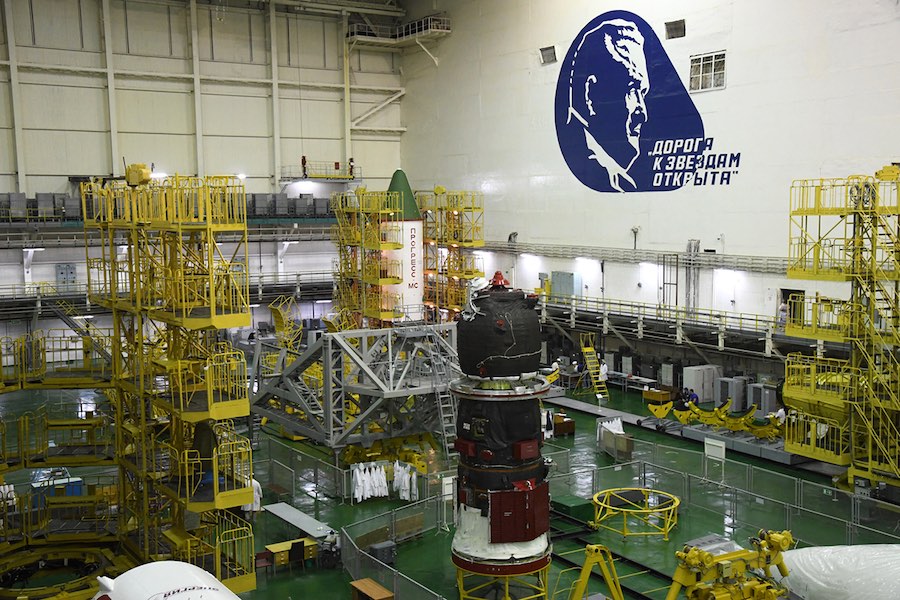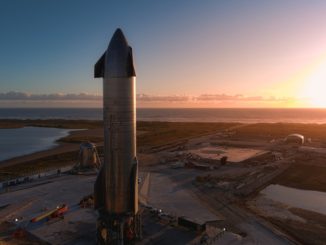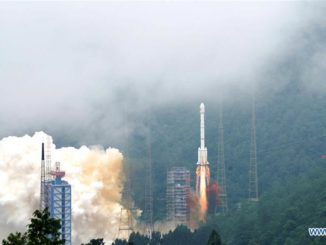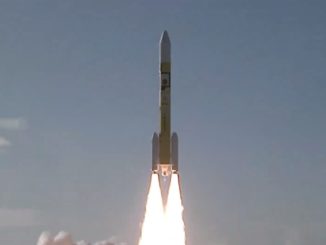Packed with nearly 3 tons of rocket fuel, water, oxygen and crew provisions, the Russian Progress MS-12 supply ship and its Soyuz booster arrived at a launch pad Sunday at the Baikonur Cosmodrome in Kazakhstan, moving a step closer to liftoff Wednesday on a fast-track three-hour flight to the International Space Station.
The automated supply carrier is set for liftoff on top of a Soyuz-2.1a booster at 1210:46 GMT (8:10:46 a.m. EDT; 5:10:46 p.m. Baikonur time) Wednesday.
Riding a rail car, the Soyuz-2.1a rocket rolled out from an assembly building at Baikonur early Monday and journeyed to Launch Pad No. 31, where ground crews raised the launcher vertical using a hydraulic lift amid rain showers and gusty winds.
Twin gantry towers moved into position around the Soyuz rocket to give workers access to the vehicle for final preflight checkouts and inspections.
The Progress MS-12 supply ship will carry more than 2,600 pounds (1.2 metric tons) of dry cargo to the space station inside the spacecraft’s pressurized compartment, including scientific equipment, components for the life support system, food, clothing, medical supplies and personal items for the research lab’s six-person crew, according to Roscosmos, the Russian space agency.

The Progress spacecraft will also launch with more than 2,200 pounds (1 metric ton) of propellant in refueling tanks to transfer inside the space station’s Zvezda service module, according to information released by Roscosmos. The Russian space agency said the resupply mission will deliver some 925 pounds (420 kilograms) of water and 110 pounds (50 kilograms) of compressed gas to replenish the space station’s breathing air.
The cargo mission is designated Progress 73P in the sequence of resupply and crew delivery flights to the International Space Station.
Assuming an on-time launch, the Progress MS-12 spacecraft is set to link up with the space station’s Pirs docking compartment at 1535 GMT (11:35 a.m. EDT) Wednesday following an accelerated two-orbit rendezvous profile.
The Progress MS-11 supply ship, loaded with trash, undocked from the Pirs module early Monday, heading for a destructive re-entry to end its mission. Most of the spacecraft, which arrived at the space station in April, was projected to burn up during re-entry, with any remaining debris expected to fall into the remote South Pacific Ocean.
The arrival of a Russian Progress cargo freighter Wednesday will mark the second supply delivery to the space station in less than a week. A SpaceX Dragon supply ship arrived at the station Saturday with 5,097 pounds (2,312 kilograms) of experiments and equipment after a two-day flight from a launch pad at Cape Canaveral.
Russian teams at Baikonur are preparing another Soyuz launch Aug. 22 with the unpiloted Soyuz MS-14 spacecraft. The mission will test the compatibility of the Soyuz MS-series spacecraft with the Soyuz-2.1a launcher, which Russia plans to begin using for crew missions next year.
The Soyuz-2.1a features a new digital guidance system and other upgrades, allowing it to carry several hundred pounds more cargo into orbit. The Soyuz-FG rocket variant previously used to ferry crews into orbit will be retired after a launch in September.
The Soyuz MS-14 spacecraft will launch without the life support systems needed for a crew flight, allowing teams to pack additional cargo into the capsule. The spacecraft will dock with the space station Aug. 24 for a 13-day stay, during which time cosmonauts will unpack the supplies and load items for return to Earth.
The Soyuz capsule parachute to a landing in Kazakhstan in early September with up to 1,100 pounds (500 kilograms) of equipment, significantly more cargo than a Soyuz crew vehicle typically returns to Earth.
Email the author.
Follow Stephen Clark on Twitter: @StephenClark1.



